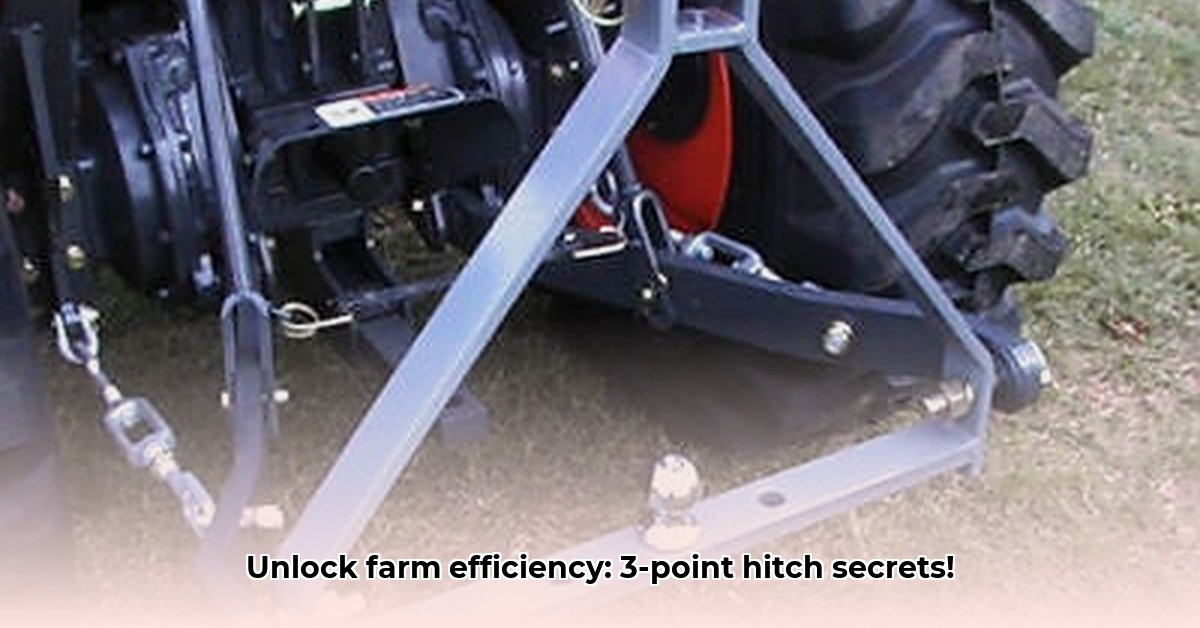
Understanding the 3-Point Hitch System
The 3-point hitch is the unsung hero of modern farming, a standardized system connecting your tractor to various implements. This versatile system uses three points of contact—two lower arms and a top link—to securely attach implements, ensuring stability and safe operation. Controlled by your tractor's hydraulics, it simplifies raising and lowering implements, saving you time and effort. Its design allows precise positioning, crucial for tasks demanding accuracy. Isn't it amazing how such a simple mechanism can revolutionize your farming operations? For more on Category 2 hitches, check out this helpful resource: Category 2 Hitches.
Types of 3-Point Hitches: Finding the Right Fit
3-point hitches are categorized primarily by size and lifting capacity. The most common categories are:
Category 1: Ideal for smaller tractors and implements, suitable for smaller farms or hobby farms. They offer a cost-effective solution for lighter tasks.
Category 2: A mid-range option balancing cost and capability. Perfect for a variety of tasks on medium-size tractors.
Category 3: Heavy-duty hitches designed for larger tractors and demanding operations. These hitches excel at handling heavier implements and large-scale farming tasks.
Here's a comparative table:
| Category | Tractor Size | Typical Lifting Capacity (lbs) | Approximate Cost Range ($) | Quick-Hitch Common? |
|---|---|---|---|---|
| Category 1 | Compact to Small | 1,500 - 3,000 | 300 - 800 | Often |
| Category 2 | Mid-size | 3,000 - 5,000 | 600 - 1,500 | Usually |
| Category 3 | Large | 5,000+ | 1,000+ | Almost Always |
Note: These are approximate ranges; always consult manufacturer specifications.
Many modern hitches include quick-hitch systems, significantly reducing implement changeover time and boosting efficiency. How much time could you save each season with a quick-hitch system?
Selecting the Right Hitch: A Step-by-Step Guide
Choosing the right hitch is crucial for optimizing farm workflow and sustainability. Follow these steps:
Assess Your Tractor: Determine its size, horsepower, and hydraulic capacity – vital for selecting a compatible hitch category.
Inventory Implements: List the tools you’ll use, considering their weight and connection requirements to determine the required lifting capacity.
Budgeting: Set a realistic budget; a higher upfront cost often translates to longer lifespan and less downtime.
Future-Proofing: Consider potential future implements; selecting a hitch with slightly more capacity avoids future upgrades.
Installation and Maintenance: Ensuring Long-Term Performance
Proper installation and maintenance are crucial for your hitch's longevity.
Installation: Always consult your tractor and hitch manuals for detailed, step-by-step instructions. Proper and safe connection is paramount.
Maintenance: Preventative maintenance is key.
Regular Inspections: Check for wear and tear, loose bolts, or damaged components.
Lubrication: Lubricate moving parts according to manufacturer recommendations.
Prompt Repairs: Address issues immediately to prevent larger problems.
Adhere to Schedules: Follow manufacturer's recommended maintenance schedules.
Sustainable Agriculture Applications: Minimizing Environmental Impact
The 3-point hitch is instrumental in sustainable farming practices. It enables the use of precision agriculture techniques, such as GPS-guided seeders and sprayers. This precise application of inputs like fertilizers and pesticides reduces waste, minimizes environmental impact, and contributes to a healthier planet. What percentage of fertilizer waste could you potentially eliminate through precision agriculture?
Troubleshooting and Common Issues: Quick Fixes for Common Problems
Here are some common hitch problems and solutions:
Hitch Not Lifting: Check hydraulic fluid levels and consult your tractor's manual.
Implement Instability: Ensure correct hitch adjustment and secure attachment.
Pin Breakage: Replace damaged pins immediately for safety.
Resources and Further Reading
For additional information, consult your local agricultural extension office, equipment dealers, and online farming communities. These resources provide valuable insights and support. Continued learning is key to optimizing farm efficiency and sustainability.
Key Takeaways: Maximizing Efficiency and Sustainability
- Matching tractor class to hitch category is essential for safety and efficiency.
- Consider implement weight and type during hitch selection.
- Regular maintenance significantly extends hitch lifespan and minimizes downtime.
- The right hitch improves fuel efficiency and reduces environmental impact.
- Investing in quality components translates to long-term cost savings.